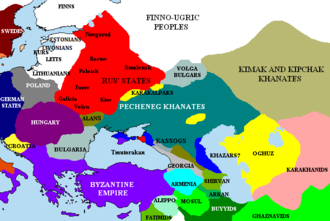Pechenegs
![]()
Pecenek is a redirect to this article. For the Turkish soccer player see Arif Peçenek.
The Pechenegs (Old Turkic Beçenek, Latin Pacinacae or Bisseni, Greek Πετσενέγοι Petsenegoi, Russian Печенеги Pečenegi, Ukrainian Печеніги Pečenihy, Hungarian Besenyő) were an important Oghuz tribe belonging to the Turkic peoples.
Mahmud al-Kajgharī mentioned them under the name Beçenek as one of the 24 Oghuz tribes. They had a gerfalcon as their totem animal. Their tribal name means "he who works well and exerts himself" in Old Turkic.
After the decline of the Göktürk Empire, the Pechenegs moved westward from western Siberia. In the process, they were eventually driven across the Volga River by other Oghuz tribes in 889. In 896 they allied with the Bulgarian Tsar Simeon I and defeated the Magyars in the area of Etelköz, north of the Black Sea. After the defeat, the Magyars moved westward, where they settled in the upper Tisza region (present-day Hungary).
The Pechenegs fought long battles with the Russians (Kievan Rus) and the Khazars living on the Volga River in the 10th century. Thus, in 968 they besieged Kiev and in 972 killed the Kievan Grand Prince Svyatoslav, who had returned from a great and unsuccessful campaign against Byzantium. At the height of their power in the 11th century, they ruled the area between the Talas and the Danube. In 1036 they were severely defeated by Svyatoslav's grandson Yaroslav the Wise, and under pressure from the Kipchaks they subsequently fled across the Danube, where they now repeatedly threatened Byzantium while also feuding with each other. King Stephen I defeated them in 1003 and 1021, but from 1061 they established themselves in Wallachia and invaded Hungary again in 1067/68.
According to Arabic reports, the first Pechenegs converted to Islam in 1009, and in 1068 a civil war broke out between the Muslim minority among the Pechenegs and the majority of other faiths, in which the Muslims won and then attacked Constantinople in alliance with the Seljuks. After the bloody defeat in 1091 at the Battle of Levounion, the Pechenegs retreated behind the Danube. Byzantium (Alexios I Komnenos) and the Kipchaks under Boniak and Tugorkhan had allied against them. Nevertheless, it remained unclear until the battle whether the Kipchaks would fight with or against the Byzantines. In order to be safe in the future, after the battle the Byzantines made a massacre among the captured Pechenegs.
Their remnants served the Byzantines for a while (Danube frontier) and disappeared in a new defeat at Beroe (Berrhoia) in 1122. Some had submitted to the Magyars and were settled in Hungary in 1123 as frontier guards of the Hungarian Gyepűsystem, others were absorbed into the related Turkic tribe of the Kipchaks and the Oghuz population of Anatolia. Nevertheless, a remnant kingdom persisted in Wallachia until 1171, before it was conquered by the Kipchaks (Cumans).
For a long time, the Christian Hungarian Pechenegs and Cumans were also considered ancestors of the Transylvanian Szekler, and the Bulgarian Pechenegs and Cumans, in turn, were considered ancestors of the Gagauz.
In Russia, seven citizens described themselves as Pechenegs in the last census in 2003, which was not taken seriously by the authorities and was not included in the final report.
However, at least in some place names in Ukraine, Turkey, Hungary, Slovakia, Russia, Romania and Moldova there are still traces of the Pechenegs. In today's Ukraine there are eight places named Pechenaya, Pechenegi, Pechenizhyn, Pechenezhskiy, Pechenki, Pechenya, Pechenyugi and Pechenyy, in Turkey seven places named Peçene and Peçenek, in Hungary six places named Besenyőtanya, Besenyőtelek, Besenyőd, Besnyő, Besnyőmajor, and Szirmabesenyő, in Slovakia five places called Bešeňov, Bešeňová, Pečeňady, Pečeňany, and Pečenice, in Russia two places called Pechenegi and Pecheniki, in Romania two places called Pecinişca and Pecineaga, and in the Republic of Moldova one place called Peceştea. Also in Austria (in Burgenland, which once belonged to Hungary) there is a place called Pöttsching, which goes back to a Pechenegian settlement.

The Pechenegs against the "Scyth" of Svyatoslav I.

The sign of the Pechenegs

Eastern Europe with settlement area of the Pechenegs around 1015
Search within the encyclopedia